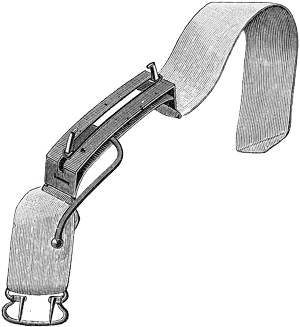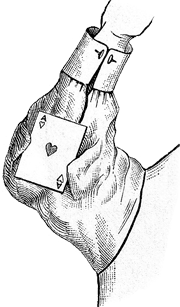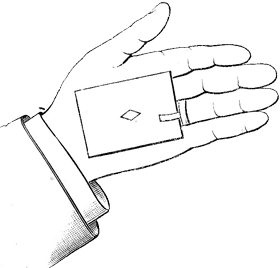
|
foreword to the online edition I. introductory II. common sharpers and their tricks III. marked cards and the manner of their employment IV. reflectors V. holdouts VI. manipulation VIII. the game of faro IX. prepared cards X. dice XI. high ball poker XII. roulette and allied games XIII. sporting houses XIV. sharps and flats
|
SHARPS AND FLATS
CHAPTER V HOLDOUTS
"Topping" the DeckIt should be noted that Maskelyne does not use any name for the holdout shown in the image below. However, in the next few paragraphs he talks about a cheating strategy called "topping the deck," (which he explains below). So, the two holdouts described on this page serve this purpose and we took the liberty to add the title Topping the Deck, which is not part of the original text.
FIG. 26 Referring to fig. 26, it will be seen that this instrument consists practically of a pair of jaws, which, being movable, will separate sufficiently to allow a card to be held between them. These jaws are drawn towards each other by means of an elastic band slipped over them. Elastic is the material commonly used in the springs of holdouts, being readily replaced when worn out or otherwise deteriorated. The projecting lever situated at the side of the machine is for the purpose of separating the jaws when the cards are to be withdrawn. The act of pressing it to one side releases the cards, and at the same time throws up a little arm from the body of the holdout, which thrusts them out. The machine is strapped around the fore-arm with the jaws underneath, and is worn inside the sleeve of the coat or, if playing in shirt-sleeves, inside the shirt-sleeve. Acting from the inside it will hold a card or cards against the under surface of the sleeve, in which position they are concealed from view by the arm. The hands being crossed, as in the case of the cuff-pocket, the cards are simply slipped between the jaws, where they are held until required. The hands being crossed for the second time, the lever is pressed and the cards fall upon the top of the pack, which is held underneath at the moment. This operation is termed technically 'topping the deck.' Fig. 27 shows the manner in which the cards are held by this machine. FIG. 27 -- Showing card held under the arm An extremely simple form of appliance, and one which may be utilized with effect, is that known as the 'ring holdout.' It is merely a small piece of watch spring fitted with a clip, enabling it to be attached to an ordinary finger-ring. Between this spring and palm of the hand the cards are held (fig. 28). With a little practice the deck may be topped, hands made up or shifted, and cards held out in a manner which is far safer and better than any 'palming,' however skillfully it may be done. Needless to say, the cards used must not be too large, or the operator's hand too small, if this device is to be employed.
FIG. 28 -- Ring Holdout It is really hard to imagine how anyone would ever get away trying to use a ring holdout (as described above) in a game of poker. First of all, the manipulation required to palm of a card (or cards) with a ring that has been fitted with a clip is by far more difficult than palming off a card without the use of any accessories. The ring is simply in the way and complicates things. Second, the illustration on fig. 28, that shows a palmed card, secured by the ring clip, is totally inaccurate. In reality a playing card is much larger than the card pictured in this drawing. So, by trying to secure a card with this kind of ring clip, the cheat risks flashing the corners and/or edges of the card(s) because this type of clip simply does not allow the operator to have a real feel for the position of the card relative to the palm. In other words, there is probably a 90% chance that the cheat would flash the edges of the card. In the illustration, the artist resolved this difficulty by simply drawing the card smaller than it should be. But at the poker table the card cheats have to use what's practical. It is quite possible that this ring holdout was just another sucker item listed the the crooked gambling catalogs.
|
| « holdouts (the cuff holdout) | holdouts (the vest holdout) » |
home | introduction | book content | links | advertising | contact


